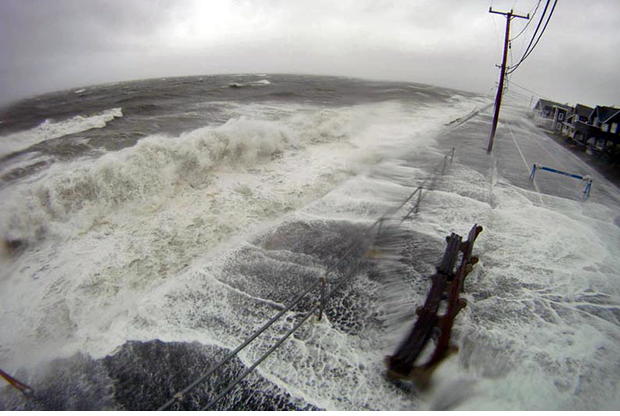Planning prof helps write report urging change in coastal policy

Phillip Berke
To contend with the rapidly escalating threat of coastal flooding along the U.S. Atlantic and Gulf coasts, government agencies need to adopt a new, fundamentally different strategy focused on flood prevention rather than recovery, according to a recent [National Research Council] (http://www.nationalacademies.org/nrc/) report that included contributions from [Phil Berke] (http://one.arch.tamu.edu/news/2013/11/26/top-planning-scholar-author-returns/) , professor of urban planning at Texas A&M University.
Berke, co-director of Texas A&M’s [Institute for Sustainable Communities] (http://www.tamug.edu/iscc/) and one of the nation’s top land use planning scholars, helped write the final [report] (http://www.nap.edu/catalog.php?record_id=18811) for the NRC research team that included coastal engineers, ecologists and environmental economists.
“Hurricane- and coastal storm-related losses have increased substantially during the past century, largely due to increases in population and development in the most susceptible coastal areas,” states the summary. “Climate change poses additional threats to coastal communities from sea level rise and possible increases in strength of the largest hurricanes.”
Current coastal flooding policy primarily involves the expenditure of federal funds on disaster recovery initiatives instead of risk reduction projects — a practice that, according to the study, leaves the communities vulnerable to future disasters.
Exacerbating the problem is the lack of central leadership or a unified vision for disaster mitigation throughout these coastal regions where, according to the report, responsibilities for coastal risk reduction are spread across numerous agencies at all levels of government, each driven by different objectives and authorities.
In the report, Berke and his fellow committee members outlined a new national vision for comprehensive coastal risk reduction focused on cooperation, unified objectives and the establishment of project priorities and planning incentives.
The report calls for the federal government to work closely with states in establishing national objectives and creating metrics for coastal risk reduction. Risk reduction initiatives, the report said, should be integrated with state and local agencies.
Federal and state governments, the report said, should also conduct a national risk assessment to prioritize areas of greatest risk where resources should be focused.
Additionally, the report calls for policymakers to establish incentives aimed at improving
pre-disaster planning efforts at the local level. For example, the federal government could award financing credits to local governments that undertake flood mitigation projects, such as wetland restoration. Such credits could be applied to other coastal protection initiatives, like beach nourishment and dune building.
The NRC report, [said] (http://dotearth.blogs.nytimes.com/2014/07/23/can-science-on-coastal-risk-reduction-compete-with-we-will-not-retreat-politics/?_php=true&_type=blogs&_php=true&_type=blogs&_php=true&_type=blogs&smid=tw-share&_r=2&) New York Times environmental blogger Andrew Revkin, should be read by everyone, particularly elected officials in coastal communities.
“Of course, the ‘we will not retreat’ and ‘bail me out’ politics in coastal communities will always cut against a science-based approach to risk reduction,” said Revkin. “But it’s great to see an effort to inject a little rational thinking into the mix.”
The report has received wide media coverage, including pieces in the Times, [Reuters] (http://in.reuters.com/article/2014/07/23/us-usa-storms-idINKBN0FS1I220140723) and [National Geographic] (http://news.nationalgeographic.com/news/2014/07/140723-gulf-atlantic-coasts-risk-report-flooding-sea-level-rise/) .
The National Research Council, an arm of the [National Academy of Sciences] (http://www.nasonline.org/) and the [National Academy of Engineering] (http://www.nae.edu/) , is a private, nonprofit group of scholars who publish expert reports and host scientific activities to improve government decision making and increase public understanding in science, engineering, technology and health.
Next Post
Tags
- archone gallery
- climate
- coa gallery
- coastal systems
- enviro gallery
- hazard reduction & recovery
- hazards
- hrrc
- hrrc gallery
- institute for sustainable communities
- interdisciplinary
- land development
- landscape architecture & urban planning
- planning
- research
- rss
- sustainability
Related Posts

Study: Focused plans help cities prepare for climate change

A&M researchers collaborate in U.S. resilience center

College community responds to Harvey

HRRC eying how disasters influence food distribution
Follow Us
Facebook Twitter Vimeo Youtube Flickr RSS
Recent Posts

Planning prof heads study of disaster housing aid

A message from the dean

Former student remembered as expert planner

Leading educator named new head of Architecture Dept.






_thumbnail_small.png)
